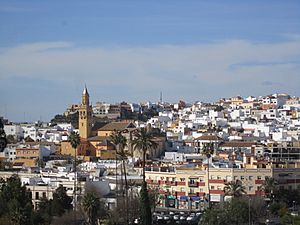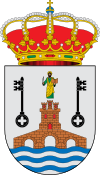Alcalá de Guadaíra facts for kids
Quick facts for kids
Alcalá de Guadaíra
|
|||
|---|---|---|---|
 |
|||
|
|||
| Country | Spain | ||
| Region | Andalusia | ||
| Province | Sevilla | ||
| Area | |||
| • Total | 284.61 km2 (109.89 sq mi) | ||
| Elevation | 46 m (151 ft) | ||
| Population
(2018)
|
|||
| • Total | 75,256 | ||
| • Density | 264.418/km2 (684.839/sq mi) | ||
| Demonym(s) | Alcalareños | ||
| Time zone | UTC+1 (CET) | ||
| • Summer (DST) | UTC+2 (CEST) | ||
| Postal code |
41500
|
||
Alcalá de Guadaíra is a town in Spain. It is about 17 kilometers (11 miles) southeast of Seville. Over time, Seville has grown so much that Alcalá has become a part of its wider urban area.
People used to call Alcalá "Alcalá de los Panaderos," which means "Alcalá of the Bakers." This was because it made most of the bread for Seville. The town is next to the Guadaíra River. You can still find old watermills there. These mills were built a long time ago, during the period when Moors lived in Spain.
Contents
History of Alcalá de Guadaíra
Long ago, a main city called Irippo was in this area. It was part of the Turdetan culture. This city even made its own coins during Roman times.
In the 8th century, Muslim forces took control of the area. They gave the town its current name, Alcalá. The word "Alcalá" comes from the Arabic word al-qalʿa. This word means "fortification" or "citadel." Many places in Spain share this name.
Alcalá de Guadaíra was ruled by different Muslim kingdoms for many years. This lasted from 756 until 1244. The Almohads, a Muslim group, built strong walls and towers on a hill overlooking the river. These old defenses still stand on the southwest side of the town today.
In 1244, Ferdinand III of Castile captured Alcalá de Guadaíra. He repaired the castle and town walls. These buildings were then used as a royal prison and a military base. After Ferdinand died, the castle fell into disrepair. It was no longer used as a prison or army barracks.
The town was also the birthplace of Leandro José de Flores (1776–1839). He was a priest and a historian.
Main Sights to See
The walls of the castle you see today were built in the 13th and 14th centuries.
The Hermitage of Our Lady of the Eagle
Inside the castle area is a special building called The Hermitage of Our Lady of the Eagle (Nuestra Señora del Águila). This building was built in the mid-13th century. It was the main church for the town back then. As the town grew, more churches were built. The church of Santiago became the most important one. Many valuable items were moved from the hermitage to Santiago. However, the image of "La Virgin del Águila" stayed there. The image of the virgin you see now is a copy. The original was damaged in 1936.
Marchenilla Castle
Nearby is Marchenilla Castle, built in the 14th century. It stands on the remains of an old Roman estate.
Economy and Industry
Alcalá de Guadaíra is known as an industrial town. Its history of industry began with the watermills. These mills were built by the Moors along the Guadaíra River. They ground grain to make flour. This flour supplied bakers in the area. Because of this, Alcalá became known as the "bread basket" of Seville.
Another important industry in the past was processing olives. In the early 1900s, there were up to 12 olive factories in Alcalá. These factories employed thousands of workers, mostly women. They prepared olives for sale after they were cured.
Both the bread and olive industries have become smaller over time. But new industries have taken their place. Today, many modern light and heavy industries are found in the industrial areas. These are located in the north and west of the town. Alcalá provides jobs for its own residents and for people from nearby towns.
Geography and Nature
Alcalá is in southern Spain. It has a Mediterranean climate. This means it has mild, wet winters and hot, dry summers. The town is on higher ground compared to Seville. This area is called Los Alcores. Alcalá is the biggest town in this region.
The Guadaíra River flows through the town. In some places, it has created a deep valley with low cliffs. The river starts to the east and southeast of the town. It then flows through Alcalá and joins the Guadalquivir River south of Seville.
For many years, the river faced pollution challenges. However, the river's banks are full of trees and plants. This makes it a home for a lot of wildlife. Until the early 1900s, the Guadaíra River was a major place for European Sturgeon to lay their eggs. This supported a successful fishing and caviar industry. In 1930, a dam was built on the Guadalquivir River near Alcalá del Río. This changed the river's flow.
On March 28, 2007, a special bridge was opened. It is called the Dragon Bridge. It is known for its unique dragon shape. This bridge is part of the town's beltway.
South of the river, there is a large forest of stone pine trees called Oromana.
Transportation
The A-92 motorway runs east to west through the northern part of the town. The A-392 road goes from northeast to southwest through the town. The Tranvía Metropolitano de Alcalá de Guadaíra is a tram system. It has been under construction since 2007. However, it had not opened as of 2020.
See also
 In Spanish: Alcalá de Guadaíra para niños
In Spanish: Alcalá de Guadaíra para niños






